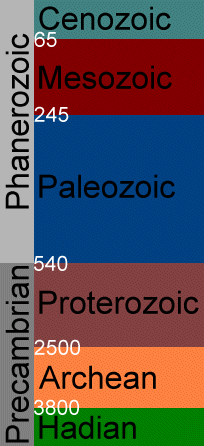In a nutshell, it is a theory that many different forms of one species are created, butonly the ones with advantages survive to reproduce, and spread these advantages.These advantages could include better camouflage, more strength, better eyesight, and so forth.Slowly, over many generations, the simple single-celled life forms, evolved into more and more complex multiple-celled organisms, adapting to the changing environment of the earth.
Past life is often referred to being a part of a certain era, or a certain point on the geological timescale. There are 6 eras on the geological timescale, consisting of the Hadean, Archaean, Protezoic, Paleozoic, Mesozoic, and the Cenozoic.
 The Hadean era did not contain life as
we know it, but rather the building blocks
of life, such as amino acid, proteins
and the like, mentioned previously. It
lasted approximately from 3.8 to 4.5 billion
years ago.
The Hadean era did not contain life as
we know it, but rather the building blocks
of life, such as amino acid, proteins
and the like, mentioned previously. It
lasted approximately from 3.8 to 4.5 billion
years ago.
This era took place from about 3.8 to 2.5 billion years ago and also saw the formation of the first cells, as described in the ’The First Cell’ section. Also, it is likely that approximately 70% of the world's landmasses where created during this era.This era saw the creation of simple bacteria and plant like algae, which could actually feed off pure energy in the form of sunlight. They became the building blocks for evolution of life , and the basis of early food chains.
This era took place approximately 2.5 billion to 544 million years ago. Many fossils have been found from this Era, mostly in the form of Bacterial life and Archaean life (Archaeans are physically similar to bacteria, but are biochemically different so much that they are considered a separate from bacteria. They are known for living in very extreme environments) About 1.8 billion years ago, eukaryotic cells began to appear (Eukaryotic cells are ones containing a nucleus, which stores genetic information. Eukaryotic cells are contained in many species today, such as plants, fungi, animals, insects and so forth.) Another important event in the Proterozoic era was the first evident of oxygen buildup in the atmosphere. This meant death for early bacteria, which could not survive in oxygen environments, but allowed eukaryotic cells to thrive.The end of this era also saw the beginnings of multi-cellular life forms, such as certain algae and simple animals.
During the Paleozoic era, many life forms began to flourish. Many of these life forms we would not recognize today. These life forms slowly evolved in the ocean, and began to step out onto land, originally with amphibious life forms, and eventually with reptiles.Marking the end of this era, here was the mass Permian extinction, approximately 245 million years ago, in which many of the life forms that once flourished died off.
The Mesozoic era has three time periods. The cretaceous (146-65 mya), the Jurassic (208-146 mya) and the Triassic (245-208) Mesozoic carries the meaning of middle animals. The Mesozoic saw the creation of many different life forms, including the famous dinosaurs. There where also many new plants, including early coniferous plants. However, many of these life forms succumbed to extinction, or evolution, and are not around today in the form they originally where.
The Cenozoic is the most current era, taking place from the last mass extinction of all land-based dinosaurs (approximately 65 million years ago) to the present day. This era saw the rise of many mammals, such as whales, the great hunter cats, as well as Humans. But it also saw the rise of the birds, insects, and many new plants, including flowering plants. Much of life as we know it today evolved during this era.